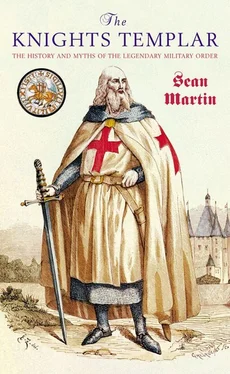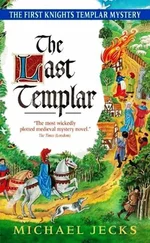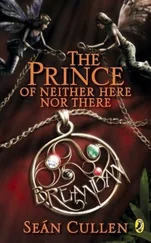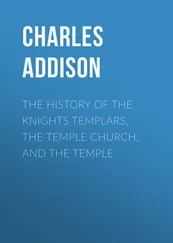Sean Martin - The Knights Templar
Здесь есть возможность читать онлайн «Sean Martin - The Knights Templar» весь текст электронной книги совершенно бесплатно (целиком полную версию без сокращений). В некоторых случаях можно слушать аудио, скачать через торрент в формате fb2 и присутствует краткое содержание. Год выпуска: 2004, ISBN: 2004, Жанр: История, на английском языке. Описание произведения, (предисловие) а так же отзывы посетителей доступны на портале библиотеки ЛибКат.
- Название:The Knights Templar
- Автор:
- Жанр:
- Год:2004
- ISBN:1-904048-28-5
- Рейтинг книги:3 / 5. Голосов: 1
-
Избранное:Добавить в избранное
- Отзывы:
-
Ваша оценка:
- 60
- 1
- 2
- 3
- 4
- 5
The Knights Templar: краткое содержание, описание и аннотация
Предлагаем к чтению аннотацию, описание, краткое содержание или предисловие (зависит от того, что написал сам автор книги «The Knights Templar»). Если вы не нашли необходимую информацию о книге — напишите в комментариях, мы постараемся отыскать её.
The Knights Templar — читать онлайн бесплатно полную книгу (весь текст) целиком
Ниже представлен текст книги, разбитый по страницам. Система сохранения места последней прочитанной страницы, позволяет с удобством читать онлайн бесплатно книгу «The Knights Templar», без необходимости каждый раз заново искать на чём Вы остановились. Поставьте закладку, и сможете в любой момент перейти на страницу, на которой закончили чтение.
Интервал:
Закладка:
If we are to understand why and how the Templars rose to such prominence so quickly after such apparently humble beginnings, we need to take a look at the background to the Jerusalem in which they found themselves at their inception, and trace the history of the city itself, right back to the original Temple of Solomon.
The First Temple
The original temple in Jerusalem was the Temple of Solomon, built by the great king around the year 950 BC. The site – known ever since as the Temple Mount or the Temple platform – had been chosen by his father, King David, who recognised it as the spot on which Abraham had prepared his son Isaac for sacrifice.
Abraham is thought to have lived 18 centuries before Christ, and was one of the founding fathers of the Jewish nation. His attempt to sacrifice Isaac symbolised both his obedience to God and his fear of Him. As Abraham raised the knife to kill his child, God spoke and ordered him to stay his hand; Abraham complied, and God was pleased. He promised Abraham that He would ‘shower blessings’ on him and make his people, the Jews, ‘as many as the stars of heaven and the grains of sand on the seashore’. 2 2 Genesis 22:12 – 18.
The spot of the attempted sacrifice came to represent, for the Jews, their unbreakable bond with God.
In addition, the Temple was to house the Ark of the Covenant, which was constructed to keep the stone tablets on which were written the Ten Commandments that Moses brought down from Mount Sinai. Like the story of Abraham and Isaac, the Commandments were tangible proof of the Jews’ covenant with the Almighty.
Solomon was reputedly the wisest of men, and his reign marks a high point of the Jewish nation; the Temple that he constructed in Jerusalem was said to have profound wisdom embodied in its architecture, and was a place of awe, pilgrimage and devotion. But it was not to last. Israel was occupied by successive invasions from the East, first by the Assyrians, and then, in 586 BC, by the Chaldeans. Their king, Nebuchadnezzar, ordered that the Temple be destroyed and the Jewish people taken into slavery at Babylon. The Chaldeans were, in turn, ousted by the Persians, whose king, Cyrus, allowed the Jews to return home in 515 BC and rebuild the temple.
Political uncertainty in the second century BC led Israel to appeal for protection from Rome. What initially started as diplomatic intervention became, by the time of Julius Caesar’s visit in 47 BC, occupation. This in turn led to much dissent and the formation of groups opposed to Roman rule. There was a general expectation of a Messiah, who would arrive and liberate the Jewish people once and for all from the tyranny of occupation. Some believed this to be Jesus, whose followers were outlawed and persecuted, being seen as agitators and, in some cases, terrorists. In AD 70, the Jews revolted. The Romans retaliated brutally, crushing the uprising; the Temple was destroyed for a second time. In 134, there was another uprising, led by Simeon ben-Koseba, who, according to the Rabbi Akiba, really was the longawaited Messiah. This was also crushed, leading to the Jews being banned from entering Jerusalem at all.
By the early fourth century, Jerusalem was becoming a Holy City for a second faith, that of the new religion of Christianity. In 312, the Roman Emperor Constantine converted, and he ordered that churches be built over the site of Christ’s birth in Bethlehem, and those of his Crucifixion and Resurrection in Jerusalem; the latter church became known as the Church of the Holy Sepulchre. However, Constantine’s nephew and successor, Julian the Apostate, did not share his uncle’s beliefs, and the Empire returned to paganism. In a blatant attempt to antagonise Christians, Julian began to rebuild the Temple (not that he had any time for the Jews, who were persecuted with equal zeal). The project did not progress smoothly, and was abandoned upon Julian’s death in 363. Jerusalem seemed destined never to have another Temple.
The Temple and the Mosque
With its administration creaking, the Roman Empire divided into two in the fourth century – the western half would still be ruled by Rome, while the eastern half had Byzantium as its capital. When Rome was overrun by the Visigoths in 410, Jerusalem became one of many jewels in the Byzantine crown. The Temple Mount became a rubbish tip.
In 638, Jerusalem surrendered to the Caliph Omar, and the city fell into Muslim hands. Since its founding by the Prophet Muhammad with the hijrah of 622, when the Prophet migrated from Mecca to Medina and thus the Muslim calendar began, Islam had spread rapidly throughout the Middle East. The Byzantines seemed powerless to stop its progress, and retreated north. Jerusalem was sacred to Muslims, in particular the Temple Mount area, as it was the site of the Prophet’s ascension to heaven. Upon his entry into Jerusalem, Omar had gone there to pray, and resolved to build the al-Aqsa mosque on the site. Towards the end of the seventh century, a second, even more impressive, mosque was built on the Temple Mount, the Dome of the Rock. Jerusalem was further than ever from Christian hands.
The First Crusade
Islam continued to impinge upon Christian Europe, with most of the Mediterranean and the Iberian peninsula falling under Muslim control during the seventh and eighth centuries. By the middle of the eleventh century, a new Islamic threat had emerged, from the Seljuk Turks. Originally from central Asia, they had moved inexorably westwards, conquering Baghdad and converting to Islam in the process. They had Byzantium in their sights, and in 1071 defeated the imperial army at Manzikert in Armenia. Within a decade, they had also taken Nicea and controlled the whole of Asia Minor. The Byzantine empire was now solely comprised of its lands west of the Bosphorous, and it was to the West that the Byzantine emperor Alexius looked for help to stave off certain annihilation.
In the spring of 1095, a delegation arrived at the Council of Piacenza in northern Italy. Although the eastern and western churches had split decisively in 1054, the Pope, Urban II, had made conciliatory moves towards Constantinople by rescinding Alexius’ excommunication, and it was therefore with some hope that the eastern delegation appealed to the council. Its plea for help did not fall on deaf ears. Urban called for a meeting of bishops to address the problem, to be held that November in Clermont.
On Tuesday 27 November 1095, after a week-long ecclesiastical conference in the cathedral, Urban addressed a huge crowd outside the walls of Clermont. He called on those assembled to desist from fighting one another, internecine warfare having dogged Europe ever since the sack of Rome in 410; he called instead that their energies be better spent fighting the infidel in the East, and returning Jerusalem into the arms of Mother Church. The crowd was ecstatic, with cries of ‘ Deus lo volt !’ – ‘God wills it!’ – echoing from the city walls. A bishop and a cardinal immediately knelt before Urban and begged to join the campaign. The First Crusade had begun.
After arriving in Constantinople in late 1096, the crusaders marched south, taking Nicea in June of the following year. Edessa and Antioch both fell in 1098, and the crusaders finally arrived outside the walls of the Holy City on 7 June 1099. Jerusalem finally fell on 15 July after a ferocious bloodbath. It was the first time it had been in Christian hands for 461 years. One of the Crusade’s leaders, Godfroi de Bouillon – after refusing to be called king on the grounds that only Christ had the right to that title – was proclaimed Defender of the Holy Sepulchre, and the Latin Kingdom of Jerusalem was thus established. In Europe, it became known as Outremer – the land beyond the seas.
Читать дальшеИнтервал:
Закладка:
Похожие книги на «The Knights Templar»
Представляем Вашему вниманию похожие книги на «The Knights Templar» списком для выбора. Мы отобрали схожую по названию и смыслу литературу в надежде предоставить читателям больше вариантов отыскать новые, интересные, ещё непрочитанные произведения.
Обсуждение, отзывы о книге «The Knights Templar» и просто собственные мнения читателей. Оставьте ваши комментарии, напишите, что Вы думаете о произведении, его смысле или главных героях. Укажите что конкретно понравилось, а что нет, и почему Вы так считаете.












